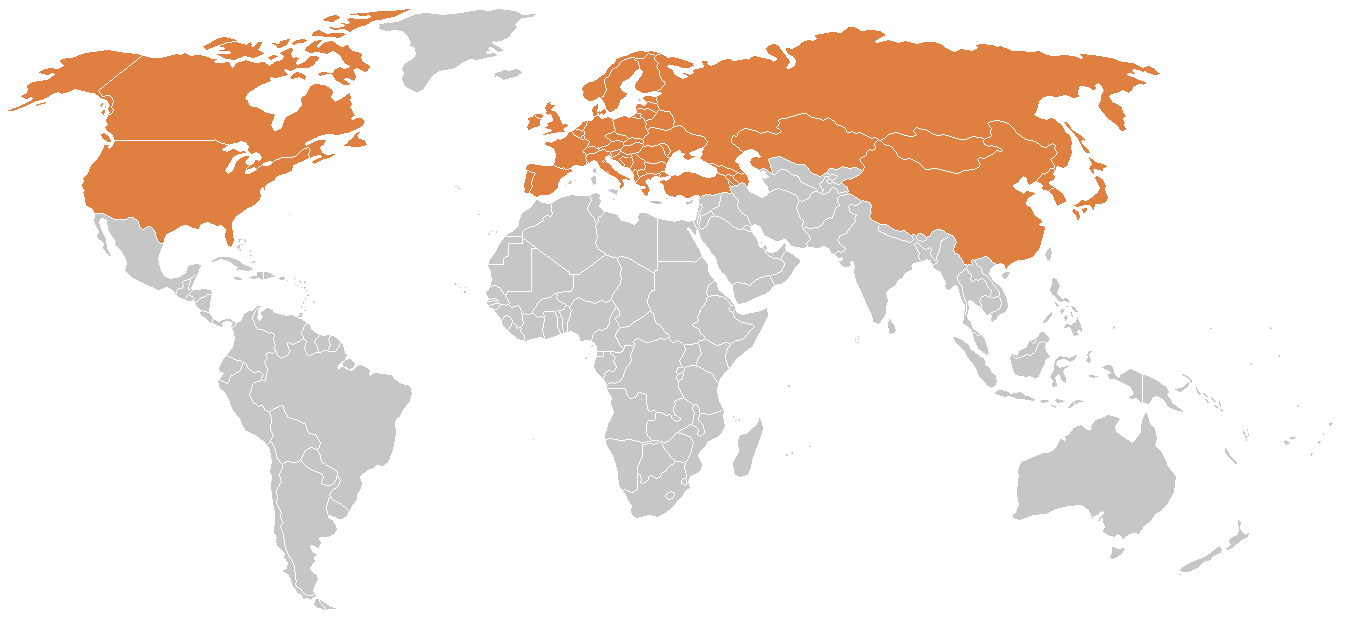Sandbox : anmol
Widespread disease and endemic regions
- The number of reported cases of the disease have been increasing, as are endemic regions in North America.
- B. burgdorferi sensu lato has been maintained in enzootic cycles in California as well as other regions throughout North America, Europe and North Africa. Indeed, the DNA of Borrelia has been detected in lizards, indicating that they can be infected.[1]
- In Europe, cases of B. burgdorferi sensu lato infected ticks are found predominantly in Norway, Netherlands, Germany, France, Italy, Slovenia and Poland, but have been isolated in almost every country on the continent. Lyme disease statistics for Europe can be found at Eurosurveillance website.
- B. burgdorferi sensu lato infested ticks are being found more frequently in Japan, as well as in northwest China and far eastern Russia.[2][3] Borrelia has been isolated in Mongolia as well.[4]
- In South America tick-borne disease recognition and occurrence is rising.
- Ticks carrying B. burgdorferi sensu lato, as well as canine and human tick-borne disease, have been reported widely in Brazil, but the subspecies of Borrelia has not yet been defined.[5] The first reported case of Lyme disease in Brazil was made in 1993 in Sao Paulo.[6] *B. burgdorferi sensu stricto antigens in patients have been identified in Colombia and in Bolivia.
- In Northern Africa B. burgdorferi sensu lato has been identified in Morocco, Algeria, Egypt and Tunisia.[7][8][9]
- In Western and sub-Saharan Africa, tick-borne relapsing fever was first identified by the British physicians Joseph Dutton and John Todd in 1905.
- Borrelia in the manifestation of Lyme disease in this region is presently unknown but evidence indicates that Lyme disease may occur in humans in sub-Saharan Africa. The abundance of hosts and tick vectors would favor the establishment of Lyme infection in Africa.[10] In East Africa, two cases of Lyme disease have been reported in Kenya.[11]
- In Australia there is no definitive evidence for the existence of B. burgdorferi or for any other tick-borne spirochete that may be responsible for a local syndrome being reported as Lyme disease.[12]
- Cases of neuroborreliosis have been documented in Australia but are often ascribed to travel to other continents. The existence of Lyme disease in Australia is controversial.
- Data shows that Northern hemisphere temperate regions are most endemic for Lyme disease.[13][14]

- ↑ Swanson KI, Norris DE (2007). "Detection of Borrelia burgdorferi DNA in lizards from Southern Maryland". Vector Borne Zoonotic Dis. 7 (1): 42–9. doi:10.1089/vbz.2006.0548. PMID 17417956.
- ↑ Li M, Masuzawa T, Takada N; et al. (1998). "Lyme disease Borrelia species in northeastern China resemble those isolated from far eastern Russia and Japan". Appl. Environ. Microbiol. 64 (7): 2705–9. PMID 9647853.
- ↑ Masuzawa T (2004). "Terrestrial distribution of the Lyme borreliosis agent Borrelia burgdorferi sensu lato in East Asia". Jpn. J. Infect. Dis. 57 (6): 229–35. PMID 15623946.
- ↑ Walder G, Lkhamsuren E, Shagdar A; et al. (2006). "Serological evidence for tick-borne encephalitis, borreliosis, and human granulocytic anaplasmosis in Mongolia". Int. J. Med. Microbiol. 296 Suppl 40: 69–75. doi:10.1016/j.ijmm.2006.01.031. PMID 16524782.
- ↑ Mantovani E, Costa IP, Gauditano G, Bonoldi VL, Higuchi ML, Yoshinari NH (2007). "Description of Lyme disease-like syndrome in Brazil. Is it a new tick borne disease or Lyme disease variation?". Braz. J. Med. Biol. Res. 40 (4): 443–56. PMID 17401487.
- ↑ Yoshinari NH, Oyafuso LK, Monteiro FG; et al. (1993). "Lyme disease. Report of a case observed in Brazil". Revista do Hospital das Clínicas (in Portuguese). 48 (4): 170–4. PMID 8284588.
- ↑ Bouattour A, Ghorbel A, Chabchoub A, Postic D (2004). "Lyme borreliosis situation in North Africa". Archives de l'Institut Pasteur de Tunis (in French). 81 (1–4): 13–20. PMID 16929760.
- ↑ Dsouli N, Younsi-Kabachii H, Postic D; et al. (2006). "Reservoir role of lizard Psammodromus algirus in transmission cycle of Borrelia burgdorferi sensu lato (Spirochaetaceae) in Tunisia". J. Med. Entomol. 43 (4): 737–42. PMID 16892633.
- ↑ Helmy N (2000). "Seasonal abundance of Ornithodoros (O.) savignyi and prevalence of infection with Borrelia spirochetes in Egypt". Journal of the Egyptian Society of Parasitology. 30 (2): 607–19. PMID 10946521.
- ↑ Fivaz BH, Petney TN (1989). "Lyme disease--a new disease in southern Africa?". Journal of the South African Veterinary Association. 60 (3): 155–8. PMID 2699499.
- ↑ Jowi JO, Gathua SN (2005). "Lyme disease: report of two cases". East African medical journal. 82 (5): 267–9. PMID 16119758.
- ↑ Piesman J, Stone BF (1991). "Vector competence of the Australian paralysis tick, Ixodes holocyclus, for the Lyme disease spirochete Borrelia burgdorferi". Int. J. Parasitol. 21 (1): 109–11. PMID 2040556.
- ↑ Grubhoffer L, Golovchenko M, Vancová M, Zacharovová-Slavícková K, Rudenko N, Oliver JH (2005). "Lyme borreliosis: insights into tick-/host-borrelia relations". Folia Parasitol. 52 (4): 279–94. PMID 16405291.
- ↑ Higgins R (2004). "Emerging or re-emerging bacterial zoonotic diseases: bartonellosis, leptospirosis, Lyme borreliosis, plague". Rev. - Off. Int. Epizoot. 23 (2): 569–81. PMID 15702720.